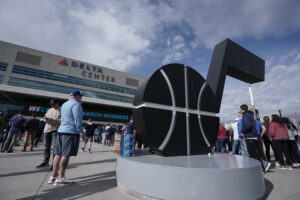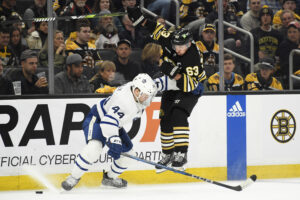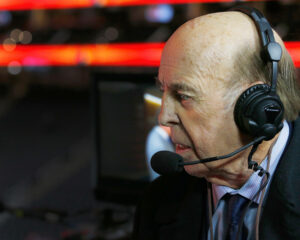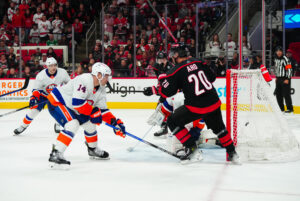Player development seems to always result in more questions than answers. How likely is it for a top pick to pan out? What makes a player a “steal”? Last Word On Hockey will be starting a new series on how to properly develop prospects from all different spots throughout the draft. This week’s piece involves top-10 picks and their likelihood of success.
Player Development of Top 10 Picks
In the span of 2005 through 2015, there were 40 total selections made between fourth overall and tenth overall on forwards playing in North America. Of those 40 selections, just one was immediately ready to make the NHL leap. There were an additional two players landing in the near-NHL ready category and handed an opportunity to play at the highest level shortly after getting drafted. For those not sure what those categories entail, check out my previous articles on top three picks, which will be listed and linked at the end of this article. For now, let’s get into those three aforementioned players.
Player Development of Sean Couturier
Being deemed the only player NHL-ready right out of the draft among players taken between fourth and tenth, Sean Couturier was seen by many as a steal. Taken at eighth overall in the 2011 NHL entry draft, Couturier out-produced (based on his DY-1 and DY points per game stats) all three of the top-three selections in juniors. Those three were Ryan Nugent-Hopkins (WHL), Gabriel Landeskog (OHL), and Jonathan Huberdeau (QMJHL). Couturier himself played in the QMJHL; he even made his NHL debut ahead of Huberdeau.
In his DY-1 season, with the Drummondville Voltigeurs, Couturier produced a staggering 96 points in 68 games played, recording a 1.412 point per game pace. He followed that up in his draft year with another 96-point season, this time in just 58 games played, for a 1.655 point per game pace. Falling directly into the laps of the Philadelphia Flyers at eighth overall, he would make an immediate impact at the NHL level.
Couturier’s Rookie and Sophomore Seasons
In his rookie campaign, Couturier played 77 games, scoring 13 goals and 14 assists for 27 total points. He did that while playing in an average of 14:08 ice time per game. He finished ninth in Calder trophy voting, and even landed in the top-50 for the Selke trophy. For the more analytical crowd, Couturier had an EVO (even-strength offense goals above replacement) of 2.8 and an EVD (even-strength defense) of 1.9. Basically, he was above replacement level as a rookie, both offensively and defensively.
For perspective, only three top-three selections in the 10-year span that’s being looked at, accomplished that feat as a rookie. Only one did it directly after being drafted (Alex Galchenyuk, believe it or not). Additionally, he recorded a 1.2 WAR (wins above replacement) and 6.8 GAR (goals above replacement). In these categories, he tied Galchenyuk in WAR and beat him in GAR, making him arguably the most impressive rookie in the noted timeframe.
As for his second year, Couturier got some AHL time with the former Flyers affiliates, the Adirondack Phantoms. He played 31 games there, scoring 28 points. Additionally, he played 46 games in the NHL with the Flyers, where he scored just four goals and 15 total points. He would actually average more ice time per game, getting an average of 15:53. Despite what was seemingly a disappointing season, he yet again was above replacement level in EVO and EVD, with a 1.1 and 1.3 score, respectively. Only one of those three top-three picks finished positive in those same categories in both their first and second years (Sam Reinhart). As for his WAR, he recorded a 0.5 score, while also recording a 2.8 GAR.
Slight Slump in Year Three
In Couturier’s third NHL season, he would play the full 82 games, registering 13 goals and 39 points. He did that while averaging 19:05 of ice time per game. Couturier would also record a 2 EVO and -0.6 EVD. On top of that, he recorded a 0.8 WAR and 4.2 GAR. Those numbers aren’t exactly remarkable, but it shows that Couturier was beginning to play tougher minutes and still playing at almost the same level as his first two seasons. Even though it was a bit of a tough year, he proved himself and his team right by staying consistent and fighting through adversity. Couturier’s player development is potentially the picture-perfect way to grow prospects. Ease him into his rookie campaign, give him a little bit more rope in year two, then set him up for a big year three.
Player Development of Sean Monahan
Sean Monahan was another forward taken between fourth and tenth in his respective class to make an immediate impact at the NHL level. However, he didn’t produce at the same level as Couturier. This put him in the “Near NHL-level” category. In juniors, he played in the OHL for the Ottawa 67’s. In his DY-1 season, Monahan recorded 33 goals and 45 assists for 78 points in 62 games, for a per game pace of 1.258, ranking sixth out of the 40 North American forwards selected between fourth and tenth overall in their DY-1 seasons. He followed that up in his draft year with 31 goals and 47 assists for another 78 points, in just 58 games. That brought his point totals up to 1.345 per game, ranking 18th among that same group in their draft years.
Monahan’s Rookie & Sophomore Seasons4
Following his draft year, he was given an immediate role in the NHL. That came in the form of 75 NHL games played, scoring 22 goals and 12 assists for 34 points. That was done while playing an average 15:59 of time on ice per game — more than Couturier played in his rookie season. With that role, Monahan would put up a 3.5 EVO and -1 EVD to go along with a 0.8 WAR and 4.2 GAR. His defensive abilities dragged him down to virtually being slightly above replacement level, which is not terrible. His offense allowed him to finish eighth in Calder Trophy voting that year.
In his second season, Monahan would see a boost in the form of games played and ice time. He played 81 games, averaging 19:37 of ice time per game, and scored 31 goals and 31 assists for 62 points. A great season for the young kid, who ultimately jumped from a decent third-liner as a rookie to a solid first liner. He would record a strong EVO of 2.6 in his new role, along with a GAR of 6.1. Unfortunately, his WAR was still not quite great, recording a 1.2, and it again was due to his poor defensive zone play. He recorded a -2.7 EVD, struggling to contain the tougher competition in his new role.
Breakout Season
In his third season, Monahan would once again play 81 contests, averaging 19:10 of ice time per game. In a relatively similar role as his second year, Monahan would post 27 goals and 36 assists for 63 points, just barely beating out his totals from the year before. Additionally, he posted a very good 9.8 EVO, a much improved -0.5 EVD, an impressive 2.3 WAR, and, finally, a really good 12.2 GAR. After having experienced the big role in year two, and playing virtually the same minutes against similar competition, Monahan was prepared to take on year three, and it showed.
Moving forward, however, Monahan would see an immediate drop in ice time in year four (17:35 per game). He ultimately lost the momentum he gained from his third year. That slight mishandling of ice time is part of the reason why Couturier remained consistent and grew into his role. Meanwhile, Monahan’s seemingly excellent year three slowly fizzled out. What went wrong for Monahan’s player development? A coaching change right after a year three where he established himself.
Player Development of Phil Kessel
Phil Kessel fell into the same category as Monahan as being near NHL ready. In his DY-1 season, playing for the USNTDP, Kessel recorded 11 goals and 14 assists for 25 points in 14 games. That led to a points per game pace of 1.78. He landed first on that aforementioned list of 40 forwards for DY-1 production, albeit in a generally weaker league. He followed that up in his draft year with 18 goals and 33 assists for 51 points in 39 games. This time he was with the University of Wisconsin. That stat line gave him a points per game pace of 1.308. He ranked 19th of those 40 forwards in DY production. Selected fifth overall in 2006, Kessel was given an immediate role with the Boston Bruins.
Kessel’s Rookie & Sophomore Season
In his first year, Kessel would play 70 NHL games and two AHL games. In those two AHL games, Kessel produced one goal. When he made the leap to the NHL, Kessel produced 11 goals and 18 assists for 29 points. He did that while averaging 14:04 per game in ice time. That ice time was the least among the three forwards being discussed in this piece in their respective rookie seasons. Unfortunately, analytics were not being recorded for Kessel’s rookie year. So, we cannot compare his stats to the two other players listed above.
In year two, Kessel would play a full 82-game season, averaging 15:14 of ice time per game. Once again, he averaged less ice time in his second year than both Monahan and Couturier did in their second seasons. Unlike those two, he played a full 82-game season. Monahan missed one game, while Couturier split between the NHL and AHL. With that role, Kessel scored 19 goals and 18 assists for 37 points. On the analytical side, Kessel had an EVO score of 7.2, an EVD score of -0.8, a WAR of 1.4, and a GAR of 8. Kessel struggled a bit defensively, but at least was better than Monahan. He did that while also being more offensively gifted than Couturier when looking at their respective year two stats.
Kessel’s Breakout Season
In his third season, Kessel played 70 games, averaging just 16:34 per game in ice time. He wouldn’t let the lack of ice time hold him back, however. He went on to score 36 goals and 24 assists for 60 points. Analytically, he improved his EVO (8.9 score), WAR (1.8) and GAR (10). However, Kessel struggled even more defensively. His EVD score fell to -4.3, which was worse than Monahan in his second season. The following year, Kessel would be dealt to the Toronto Maple Leafs. That’s where he became a stand-out player and finally received the ice time he rightfully deserved. It’s clear that Kessel’s player development is an interesting case study. The Bruins eased him in a bit too much, but dealt him at just the right time. This allowed him to blossom in Toronto.
Where Are They Now?
Couturier still plays for the Flyers and remains an instrumental part for the team. He has been a consistent Selke Trophy candidate for years as an elite two-way forward. He scored 76 points in the 2017-18 and 2018-19 seasons, which were both 82 games long. Over the last two seasons, had they gone for 82 games, he was on pace for 71 and 75 points, respectively. He also won a Selke Trophy in 2019-20.
Monahan also still plays for his original team, the Calgary Flames. After his third season, which was analytically a breakout, Monahan saw a decline in his play. Only once did he have better analytics, specifically with his EVO, since that third season. That can be attributed to his immediate decline in ice time from year three to year four, as he saw a near two minute decline in average ice time per game. However, the clear reason for that decline was a coaching change. After year three, the Flames let go of Bob Hartley and replaced him with Glen Gulutzan.
Phil Kessel’s Carousel
Upon entering the Maple Leafs locker room, Kessel saw his ice time jump up by almost three minutes per game, averaging first line minutes. Analytically, his offense in Toronto was inconsistent. His defensive game initially saw an improvement, but steadily fell each passing year. In fact, his last season in Toronto saw Kessel record a -8.8 EVD score, which is simply terrible. His raw stats were a little all over the place as well, recording 55, 64, 82, 52, 80, and 61 points, respectively, in his six full seasons with the Maple Leafs.
After those six seasons in the Six, Toronto would deal Kessel to the Pittsburgh Penguins. There he would win back-to-back Stanley Cup titles. Playing four seasons with Pittsburgh, Kessel would again see really poor defensive analytics and inconsistent offensive analytics. His EVO scores were 8.3, 5, 11.3, and 5, respectively, in those four seasons. His raw stats were a bit more consistent, scoring 59, 70, 92 and 82 points, respectively.
Hot Dog Phil in the Desert
After his fourth season with Pittsburgh, he was once again dealt away. This time, he landed with the Arizona Coyotes, where he currently remains today. Over the last two shortened seasons, Kessel has seen his two worst EVO scores in his career (-4.8 and 2.1). He’s also had a career-worst WAR total in 2019-20 (-1.1). His point totals are the worst of his career since the 2008-09 season, his last with the Bruins. It doesn’t help that he has yet to reach the same ice time averages he saw in Toronto. Since leaving the Maple Leafs, he has yet to surpass 19 minutes of ice time per game. In fact, over the last four years, his ice time has diminished slowly, from 18:41 to 17:05. It’s clear, despite his inconsistency, that Kessel’s player development was corrected by the trade from Boston to Toronto.
Main Photo: Embed from Getty Images






